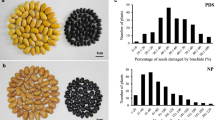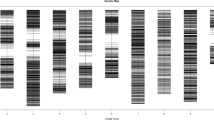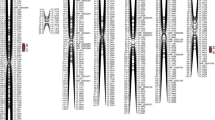Abstract
Six faba bean parents and their F1 and F2 generations were used in this investigation to study the genetic system controlling resistance of faba bean (Vicia faba L.) to broomrape (Orobanche crenata). Most of the F1 hybrids were tolerant to broomrape. In the F2 generation, the population P5 × P6 (Assiut 125 × Romy 12) gave the highest value of relative yield and tolerance index. Heterosis and inbreeding depression were only positive in number of tillers/plant and seed yield/plant characters. The results indicated that the additive effect was more important than the dominance one (D > H1) only for No. of pods/plant in the F1 generation. Moreover, the narrow-sense heritability was low for most of the studied traits. Three molecular marker systems, namely RAPD, ISSR and SRAP were used for identification and estimation of the genetic diversity among the six faba bean genotypes. The three molecular markers generated DNA unique bands for all genotypes. Only, eight DNA fragments were related to Orobanche tolerance. Clearly and reproducible polymorphic markers were subjected to QTL analysis. The linkage analysis showed that, out of 34 marker loci segregated in the F2 population, 29 (85.29%) were mapped on three linkage groups. QTL analysis using SIM method performed for the 29 markers assigned to LG-1, LG-2 and LG-3 with the eight traits, number of tillers/plant, plant height, number of pods/plant, seed yield/plant, number of broomrape spikes per plant, height of broomrape spikes, relative yield and tolerance index, showing 12 putative QTLs for all traits except number of tillers/plant. From this study, it is clear that P5 × P6 (Assiut 125 × Romy12) population could be considered promising for selection for resistance to broomrape infestation.








Similar content being viewed by others
References
El-Hady MM, El-Emam EAA (2012) Investigations on faba beans, Vicia faba L. 29. Improving yield and its components in two populations through early pedigree selection. Egypt J Plant Breed 16(4):1–14
Hazem AO, Naheif EMM, Khaled AGA (2015) Inbreeding, outbreeding and RAPD markers studies of faba bean (Vicia faba L.) crop. J Adv Res 6:859–868
Duc G, Bao S, Baum M, Redden B, Sadiki M, Suso MJ, Vishniakova M, Zong X (2010) Diversity maintenance and use of Vicia faba L. genetic resources. Field Crops Res 115:270–278
Crépon K, Marget P, Peyronnet C, Carrouée B, Arese P, Duc G (2010) Nutritional value of faba bean (Vicia faba L.) seeds for feed and food. Field Crop Res 115:329–339
Rubiales D (2010) Faba beans in sustainable agriculture. Field Crops Res 115:201–202
Nassef DMT (2005) Genetic variation in growth, yield and quality characteristics in faba bean (Vicia faba L.). PhD thesis, Faculty of Agriculture, Assuit University
Stoddard FL, Nicholas AH, Rubiales D, Thomas J, Villegas AM (2010) Integrated pest management in faba bean. Field Crops Res 115:308–318
Falconnier GN, Journet EP, Bedoussac L, Vermue A, Chlébowski F, Beaudoin N, Justes E (2019) Calibration and evaluation of the STICS soil-crop model for faba bean to explain variability in yield and N2 fixation. Eur J Agron 104:63–77
Abdel-Aty MSM, El-Galaly Ola AM, Soliman AAM (2016) Heterosis and combining ability for yield, yield components and inheritance of tolerance to Orobanche in faba bean. Egypt J Plant Breed 20(2):397–412
Gressel J, HanaWA Head G, Marasas W, Obilana AB, Ochanda J, Souissi T, Tzotzos G (2004) Major heretofore intractable biotic constraints to African food security that may be amenable to novel biotechnological solutions. Crop Protect 23:661–689
Parker C (2009) Observations on the current status of Orobanche and Striga problems worldwide. Pest Man Sci 65:453–459
Rubiales D, Pérez-de-Luque A, Fernández-Aparico M, Sillero J, Román B, Kharrat M, Khalil S, Joel D, Riches C (2006) Screening techniques and sources of resistance against parasitic weeds in grain legumes. Euphytica 147:187–199
Rubiales D, Fernández-Aparicio M, Wegmann K, Joel DM (2009) Revisiting strategies for reducing the seedbank of Orobanche and Phelipanche spp. Weed Res 49:23–33
Pérez-de-Luque A, Lozano MD, Moreno MT, Testillano PS, Rubiales D (2007) Resistance to broomrape (Orobanche crenata) in faba bean (Vicia faba): cell wall changes associated with prehaustorial defensive mechanisms. Ann Appl Biol 151:89–98
Rubiales D (2003) Parasitic plants, wild relatives and the nature of resistance. New Phytol 160:459–461
Cubero JI (1983) Parasitic diseases in Vicia faba L. with special reference to broomrape (Orobanche crenata Forsk.). In: Hebblethwaite PB (ed) The faba bean. Butterworths, London, pp 257–277
Román B, Torres AM, Rubiales D, Cubero JI, Satovic Z (2002) Mapping of quantitative trait loci controlling broomrape (Orobanche crenata Forsk.) resistance in faba bean (Vicia faba L.). Genome 45:1057–1063
Valderrama MR, Roman B, Satovic Z, Rubiales D, Cubero JI, Torres AM (2004) Locating genes associated with Orobanche crenata resistance in pea. Weed Res 44:323–328
Díaz-Ruiz R, Torres AM, Satovic Z, Gutierrez MV, Cubero JI, Román B (2010) Validation of QTLs for Orobanche crenata resistance in faba bean (Vicia faba L.) across environments and generations. Theor Appl Genet 120:909–919
Yassine Y, Hannachib H, Ali F (2014) Genetic diversity of Vicia faba L. based on random amplified polymorphic DNA and simple sequence repeat markers. Acta Bot Gallica Bot Lett 161(2):151–158
Dora SA, Rady MM, Abou-Shosha AA, Aziza A, Kalboush SF (2017) Nature of gene action and efficiency of molecular markers for evaluation of genetic polymorphism for Orobanche tolerance in faba bean (Vicia faba L.). J Agric Chem Biotechnol Mansoura Univ 8(2):47–56
Alghamdi SS, Al-Faifi SA, Migdadi HM, Ammar M, Siddique K (2011) Inter-simple sequence repeat (ISSR)-based diversity assessment among faba bean genotypes. Crop Pasture Sci 62(9):755–760
Salazar-Laureles ME, Pérez-López DJ, González-Huerta A, Vázquez-García LM, Valadez-Moctezuma E (2015) Genetic variability analysis of faba bean accessions using Inter-simple sequence repeat (ISSR) markers. Chil J Agric Res 75(1):122–130
Megahed HA, Alghamdi SS, Migdadi HM, Khan MA, El-Harty EH, Al-Faifi SA (2015) Assessment of genetic diversity among faba bean genotypes using agro-morphological and molecular markers. Saudi J Biol Sci 22:340–350
Akash MW, Al-Awaida W, Ateyyeh A, Al-Debei H, Saleh M, Zatimeh A, Salameh N, Alawin M, Hasan SM (2017) Exploring genetic variations in faba bean (Vicia faba L.) accessions using newly developed EST-SSR markers. Pak J Bot 49(2):667–672
Tomás D, Dias AL, Silva M, Oliveira HR, José-Suso M, Viegas W, Veloso MM (2016) Genetic diversity assessment of portuguese cultivated Vicia faba L. through IRAP markers. Diversity 8(2):1–11
Alghamdi SS, Al-Faifi SA, Migdadi HM, Khan M, El-Harty EH, Ammar M (2012) Molecular diversity assessment using sequence related amplified polymorphism (SRAP) markers in Vicia faba L. Int J Mol Sci 13:16457–16471
Alghamdi SS, Al-Faifi SA, Migdadi HM, Al-Rowaily SL, El-Harty EH, Farooq M (2017) Genetic diversity and field performance of mung bean, faba bean and lentil genotypes in the kingdom of saudi arabia. Int J Agric Biol 19(4):689–696
Beavis WD, Grant D, Alberston M, Fincher R (1991) Quantitative trait loci for plant height in four maize populations and their associations with qualitative genetic loci. Theor Appl Genet 83:141–147
Timmerman-Vaughan GM, McCallum JA, Frew TJ, Weeden NF, Russell AC (1996) Linkage mapping of quantitative trait loci controlling seed weight in pea (Pisum sativum L.). Theor Appl Genet 93:431–439
Webb DM, Baltazar BM, Rao-Arelli AP, Schupp J, Clayton K, Keim P, Beavis WD (1995) Genetic mapping of soybean cyst nematode race-3 resistance loci in the soybean PI 437.654. Theor Appl Genet 91:574–581
Satovic Z, Torres AM, Cubero JI (1996) Genetic mapping of new morphological, isozyme and RAPD markers in Vicia faba L. using trisomics. Theor Appl Genet 93:1130–1138
Román B, Satovic Z, Avila CM, Rubiales D, Moreno MT, Torres AM (2003) Locating genes associated with Ascochyta fabae resistance in Vicia faba L. Aust J Agric Res 54:85–90
Han Y, Li D, Zhu D, Li H, Li X, Teng W, Li W (2012) QTL analysis of soybean seed weight across multi-genetic backgrounds and environments. Theor Appl Genet 125(4):671–683
Kramer CC, Polewicz H, Osborn TC (2009) Evaluation of QTL alleles from exotic sources for hybrid seed yield in the original and different genetic backgrounds of spring-type Brassica napus L. Mol Breed 24:419–431
EL-Marsafawy TS (2006) Faba bean selection and inheritance of Orobanche tolerance. PhD thesis, Faculty of Agriculture, Cairo University
Steel RG, Torrie JM (1997) Principles and procedures of statistics, 3rd edn. McGraw-Hill, New York
Hyman BI (1954) The analysis of variance of diallel tables. Biometrics 10:235–244
Hyman BI (1958) The theory and analysis of diallel crosses. II- Genetics 43:63–85
Mather K, Jinks JL (1971) Introduction to biometrical genetics. Cornell University Press, New York
Darwish DS, Abdalla MMF, El-Metwally MA, El-Sherbeeny MH, Attia Sabah M (1999) Investigations on faba beans, Vicia faba L. 13-Performance of some faba bean genotypes and their hybrids under Orobanche-infestation. Egypt J Plant Breed 3:231–246
Murray MG, Thompson WF (1980) Rapid isolation of high molecular weight plant DNA. Nucleic Acids Res 8:4321–4325
Dice LR (1945) Measures of the amount of ecologic association between species. Ecology 26:297–302
Rohlf FJ (2000) NTSYS-PC: numerical taxonomy and multivariate analysis system, version 2.1. Exeter Software, New York
Ooijen Van (2004) MapQTL®5, software for the mapping of quantitative trait loci in experimental populations. Kyazma BV, Wageningen
Lander ES, Green P, Abrahamson J, Barlow A, Daly MJ, Lincon SE, Newburg L (1987) Mapmaker: an interactive computer package for constructing primary linkage maps of experimental and natural populations. Genomics 1:174–181
Lincoln S, Daly MJ, Lander ES (1992) Mapping genes controlling quantitative traits with MAPMAKER/QTL. Technical Report, Whitehead Institute, Cambridge, MA, pp 2–43
Nassef DMT, Abdel-Sabour GAK, Hosseny MH (2007) Genetic studies for some agronomic characters in faba bean (Vicia faba L.). Assiut J Agric Sci 38(4):117–137
Abdel-Rahman Mona S, Abdel-Hamid MAB, Waly EA, Abdel-aal SA (2012) Diallel analysis of some characters among five new faba bean lines. Assiut J Agric Sci 43(3):85–100
Abdalla MMF, Darwish DS (2002) faba bean breeding in Egypt for tolerance to orobanche: a review. Egypt J Plant Breed 6(1):143–160
Rubiales D, Rojas-Molina MM, Sillero JC (2016) Characterization of resistance mechanisms in faba bean (Vicia faba) against broomrape species (Orobanche and Phelipanche spp.). Frontiers in Plant Science 7:1–8
Abdalla MMF, Darwish DS (1999) Breeding faba bean for Orobanche tolerance using the concept of breeding for uniform resistance. In: Kroschel J, Abderabihi A, Betz H (eds) Advances in parasitic weed control on farm level, vol II. Joint action to control Orobanche in the WANA region. Magraf Verlag, Weikersheim, pp 205–213
Cubero JI, Moreno MT (1979) Agronomical control and sources of resistance in Vicia faba to Orobanche crenata. In: Bond DA, Scarascia-Mugnozza GT, Poulsen MH (eds) Some current research on Vicia faba in Western Europe. Commission of the European Communities, Luxemburg, pp 41–80
Gil J, Martin LM, Cubero JI (1987) Genetics of resistance in Vicia sativa to Orobanche crenata Forsk. Plant Breed 99:134–143
Cubero JI, Pieterse AH, Khalil SA, Sauerborn J (1994) Screening techniques and sources of resistance to parasitic angiosperms. Euphytica 73:51–58
Bakheit BR, Ismail A, ElShimy AA, Sedeck MA (2000) Triple test cross analysis in four sesame crosses (Sesamum indicum L.). Yield–yield components and wilt infection. Acta Agron Hung 48:363–371
Hamouda MAA (2001) Diallel analysis for some agronomic and quality characters in sesame (Sesamum indicum L.). MSc thesis, Faculty of Agric, Zagazig Univ, Egypt
Sarvanan T, Thirugnana SK, Ganesan J (2000) Combining ability and heterosis for earliness characters in sesame (Sesamum indicum L.). Sesame Safflower Newsl 15:7–13
Saravanan T, Thirugnana SK, Gansan J (2000) Genetic of earliness characters in sesame (Sesamum indicum L.). Sesame Safflower Newsl 15:14–18
Zeinab Ghareeb E, Helal AG (2014) Diallel analysis and separation of genetic variance components in eight faba bean genotypes. Ann Agric Sci 59(1):147–154
Alghamdi SS (2009) Heterosis and combining ability in a diallel cross of eight faba bean (Vicia faba L.) genotypes. Asian J Crop Sci 1(2):66–76
El-kheir A, Zakia A, Abdel-Hady MS, Hoda MH, El-Naggar, Asmaa R, Abd-El-Hamed (2010) Molecular and biochemical markers of some Vicia faba L. cultivars in response to broomrape infestation. Nat Sci 8(11):252–260
El-Sayed AF, Soliman SSA, Ismail TA, Sabah MA (2013) Molecular markers for Orobanche crenata resistance in faba bean (Vicia faba L.) using bulked segregant analysis (BSA). Nat Sci 11(1):102–109
Abdalla MMF, Shafik MM, Attia Sabah M, Ghannam Hend A (2016) Molecular characterization of Orobanche crenata in Egypt using issr markers and its relation to faba bean breeding. Biotechnol J Int 16(3):1–11
Gutiérrez N, Palomino C, Satovic Z, Ruiz-Rodríguez MD, Vitale S, Gutiérrez MV, Rubiales D, Kharrat M, Amri M, Emeran AA, Cubero JI, Atienza SG, Torres AM, Avila CM (2013) QTLs for Orobanche spp. resistance in faba bean: identification and validation across different environments. Mol Breed 32:909–922
Ballvora A, Flath K, Lu BJ, Strahwald J, Tacke E, Hofferbert HR, Gebhardt C (2011) Multiple alleles for resistance and susceptibility modulate the defense response in the interaction of tetraploid potato (Solanum tuberosum) with Synchytrium endobioticum pathotypes 1, 2, 6 and 18. Theor Appl Genet 123:1281–1292
Bassou A, del-Moral L, Leon A, Velasco L, Jose M, Martínez F, Pérez-Vich B (2016) Genetic study of recessive broomrape resistance in sunflower. Euphytica 209:419–428
Collard BCY, Jahufer MZZ, Brouwer JB, Pang ECK (2005) An introduction to markers, quantitative trait loci (QTL) mapping and marker-assisted selection for crop improvement: the basic concepts. Euphytica 142(1–2):169–196
Acknowledgement
The authors would like to deeply appreciate the support provided by the Faculty of Agriculture, Assiut University, Egypt.
Author information
Authors and Affiliations
Corresponding author
Ethics declarations
Conflict of interest
The author declares no conflict of interest.
Research involving human participants and/or animals
:This article does not contain any studies with human or animal subjects.
Additional information
Publisher's Note
Springer Nature remains neutral with regard to jurisdictional claims in published maps and institutional affiliations.
Electronic supplementary material
Below is the link to the electronic supplementary material.
Rights and permissions
About this article
Cite this article
Abd El-Fatah, B.E.S., Nassef, D.M.T. Inheritance of faba bean resistance to Broomrape, genetic diversity and QTL mapping analysis. Mol Biol Rep 47, 11–32 (2020). https://doi.org/10.1007/s11033-019-05101-1
Received:
Accepted:
Published:
Issue Date:
DOI: https://doi.org/10.1007/s11033-019-05101-1




